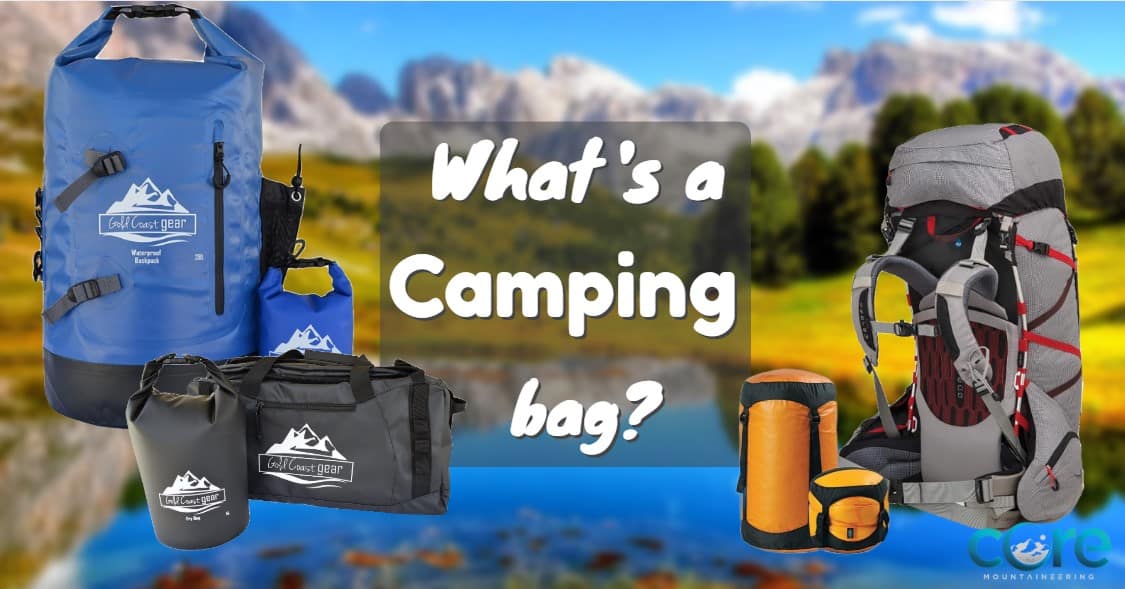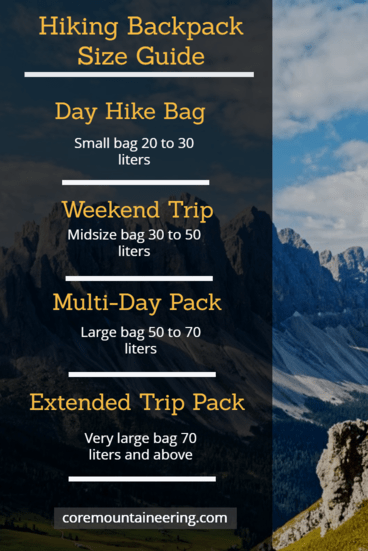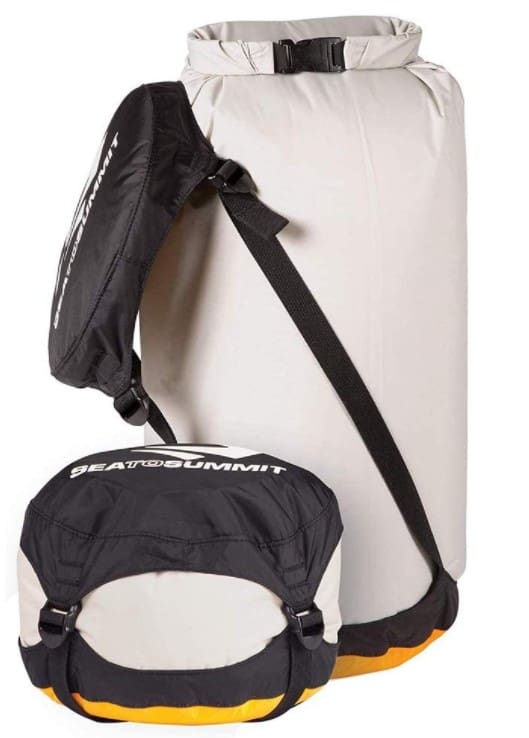A camping bag is any container made of flexible material with an opening, used for carrying outdoor gear. That’s the definition but really a camping bag is a container specifically made for the type of camping and hiking you intend to do. Different style bags are used for all applications outdoors. The most common bag for all styles of hiking and camping is a hiking backpack.
These come in two major categories, external and internal frame. For car camping or family camping, a large duffel bag is useful due to the ease of pulling gear out of the large compartment. One specialized group of hikers is Ultralight Backpackers. This style of backpacking emphasizes carrying the lightest and simplest gear safely possible for a given trip.
The correct bag can make or break your camping trip. Let’s look at a few things to consider and different styles of bags that will suit every outdoor enthusiast’s needs.
Capacity
Keep in mind if you know you’ll be eating in town or sharing a tent with someone you might not need a large backpack. These size recommendations are going to depend on the activities you have planned.
As you get more experience or have gear fever you’ll end up with a few different size bags.
Day Hike Bag
This is a small bag around 20 to 30 liters in size. It’s going to be the smallest of backpacks for hiking because you don’t need sleeping gear. Without having to carry a tent, sleeping bag, and overnight food this pack will be easy to carry. A few items to consider for a day hike are:
- knife
- Food Bars
- Map
- Space Blanket & First Aid kit
- Headlamp
- Water
- Sweater Depending on Weather
Even though your phone has a flashlight on it a headlamp or extra flashlight is a good idea in case you push the daytime limit and are walking to your car at night.
Consider using a dry bag for a day bag. I go into more detail about them below but essentially they are a simple waterproof bag with a folding top that varies in different sizes and colors. A 20-liter dry bag with a shoulder strap can make a nice day hiking bag that’s a cheaper alternative to a dedicated backpack.
Osprey backpacks are a favorite of hikers everywhere, and they have the perfect day packs for those who enjoy quick hikes. If you’re looking for something light but still durable, I recommend checking out their Tempest 20 model that has been hailed by many as being one of Ospreys’ best models to date. Our friend Ellie gets into more detail about this backpack in her full hands-on review over at averagehiker!
Backpacking Weekend Trip
30 to 50 liters backpacks are great for overnight and weekend trips. This size bag can be used for warmer weather where you don’t need a ton of winter gear. They are large enough for a tent and overnight gear.
If you’re just starting out camping and hiking this is the size I’d recommend. You can always get a larger size to more experience you get on the trail.
Backpacking Multi-Day Pack
50 to 70 liters. This is great for carrying a few layers of clothing and extra fuel. It’s usually the size hiking backpack I take with me. This is a very common size for people on the trail that are going to be out for a few days.
Backpacking Extended Trip Pack
70 liters and above. There is a thing as overkill, but this can be the perfect size for long outings. These are made to haul a ton of gear for extended long trips in the mountains. Great for mountaineering and winter backpacking.
Also great if you’re going with children and you’re going to be carrying their gear as well.
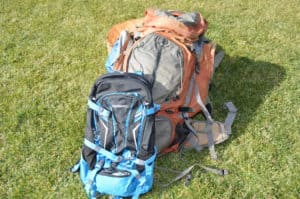
Hiking Backpacks
A hiking backpack is designed to transfer most of the weight to your hips. The weight feels about 20% on your shoulders and 80% on your hips. The two most common types are internal and external frames. The internal frame is the most common type of hiking backpack nowadays.
Internal Frame Backpack
An internal frame backpack is lighter than an external frame backpack while staying tight on your body. As I mentioned above, internal frames are more common, partially because they have a better balance on your back.
They’re not going to move or float on your back like an external frame. With this style of backpack, it will be easier to traverse terrain because the backpack hugs your body more for better balance.
External Frame Backpack
An external frame backpack is going to be heavier than an internal frame. They’re less common today but I do see them out on the trail. An external frame is going to feel different on your back than an internal frame. The external frame pack has a much higher center of gravity therefore you’ll walk more upright. These backpacks are popular among hunters that need to attach a ton of gear to the frame.
Hiking Backpack Features
Hiking backpacks are going to have a top compartment that usually opens up with a pull cord. Side compartments for quick access to smaller gear like sunglasses, lip balm, or a thin windbreaker.
A common feature is a top compartment unclicking for complete removal, becoming a small day pack or fanny pack. They usually have a water bladder compartment on the inside to stay hydrated. They will have at least one pocket on the side of the backpack for a water bottle that you can grab while hiking.
Another common feature is a daisy chain on the outside for attaching tools or trekking poles. I like to keep my tent poles on the outside of my pack if they’re wet. This is so I don’t get anything wet inside my pack.
I only covered some of the more common features. There’s a ton of features to look for that add value but remember that each feature adds weight so choose what necessary.
Ultralight Backpacks
I’m not an ultra-light enthusiast, I like to bring extra luxuries with me when camping and hiking but I do get the appeal of bringing a light load. Reducing the amount of weight you bring backpacking you’ll be more comfortable and save energy.
Ultralight and lightweight backpacking are pretty much the same things but with different weight distinctions. A lightweight backpack will have a base weight of 20 lbs or less while an ultralight backpack will have a base weight of or 12 lbs or less. The same concepts apply to both.
Ultralight bags are going to be smaller and lighter than a conventional hiking backpack.
These packs weigh less because you’re going to be using less gear and the gear you are bringing will be lighter.
While they don’t do as good a job transferring weight to your hips as an internal frame hiking backpack; with a light load, you may not need that. They are basically rucksacks with shoulder straps. They do offer some protection and comfort when hiking, though.
When choosing to go lightweight keep three things in mind:
- Leave unnecessary gear at home. Do you really need a camping chair or those extra clothes?
- Replace the heaviest items with lighter ones. A tent might not be necessary and can be easily replaced with a tarp for shelter.
- Focus on multi-purpose items. Your dry bag can be used as anything from a Bear Bag to a Clothing Wash System.
Check out my article about all the alternative uses of dry bags here.
Camping Duffel bags
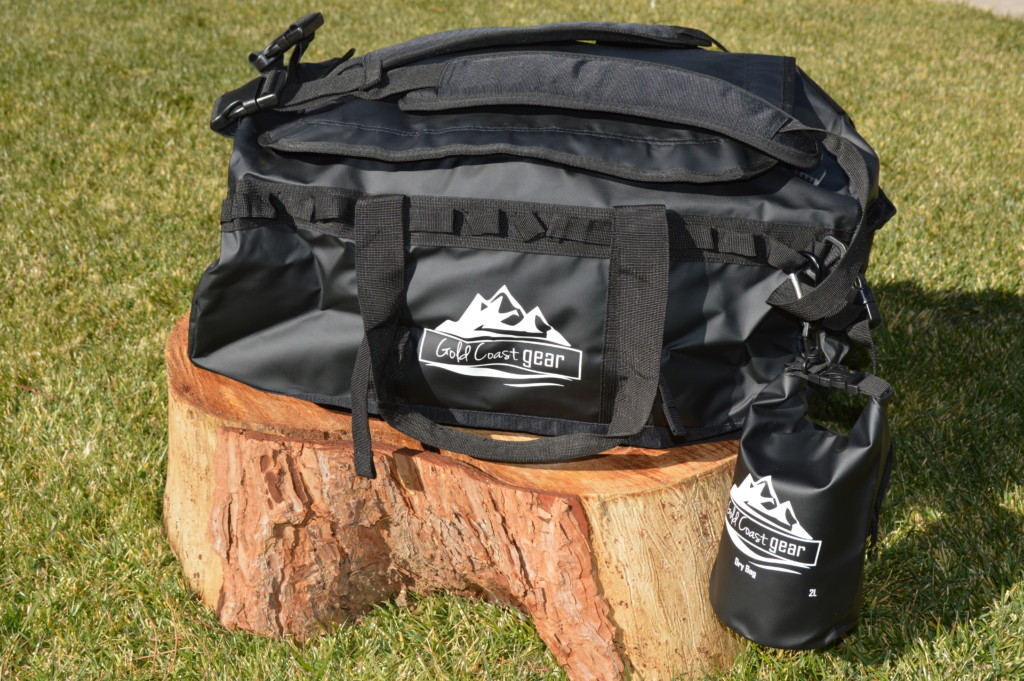
Duffel bags are gaining more popularity in the outdoor world. Duffel bags are popular among all kinds of campers. They’re easy to load, carry and they’re built rugged to take a beating. I like duffel bags because their efficient at using space, while your gear is easy to access.
When choosing a duffel bag it should be able to take a large volume of gear while still being water-resistant or waterproof.
Every camping duffel bag should be highly functional and comfortable with a few different ways of holding and strapping onto your body.
When hiking long distances there’s no replacement for a proper backpack. A duffel can have shoulder straps, a sternum strap as well as a hip belt but I wouldn’t want to hike miles even with a light load. With that being said there’s still plenty of advantages with a duffel.
When empty, a duffel folds down to a small size, smaller than a hiking backpack. With large-size duffels, it’s easy to load up all of the family’s camping gear and throw it in the back of the truck. With a giant main compartment, they’re easy to unload at the campsite.

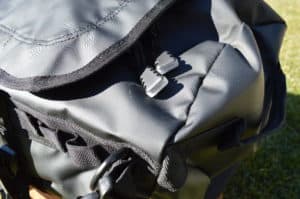
Hiking Rucksack
A rucksack is essentially a large rugged waterproof backpack. They’re made to carry heavy loads long distances. This, in large part, is why the military uses them. While a backpack can do the same things, a rucksack is designed with your comfort in mind.
Dry Bags
A dry bag is a waterproof sack that has a roll-top enclosure. They are essential for the outdoor enthusiast. The advantage of the roll-top dry bag is they are completely waterproof and durable in extreme weather. The top isn’t going to snag, break or blow out like a zipper.
Dry bags are typically measured in liters. Sometimes the size is displayed on the outside of the bag, but every manufacturer should have a wide range of sizes available.
From 1 liter up to 30 liters with a shoulder strap is a good range for dry bags before the need for a full-on waterproof backpack or duffel bag. Anything 30 liters or larger a backpack or duffel bag is more appropriate. They do make 100-liter dry bags, but those are more at home on top of an SUV than on your shoulder.

Waterproof Hiking Backpacks
A waterproof roll-top backpack is great if you know you’re going to be in wet weather or on the water. They are like a large dry bag with more features and pockets on the sides. They’re not meant to be fully submerged all the time, but they will be fully waterproof in heavy rain or a quick dip in the water. This bag is at home with kayakers or anyone that enjoys water sports.
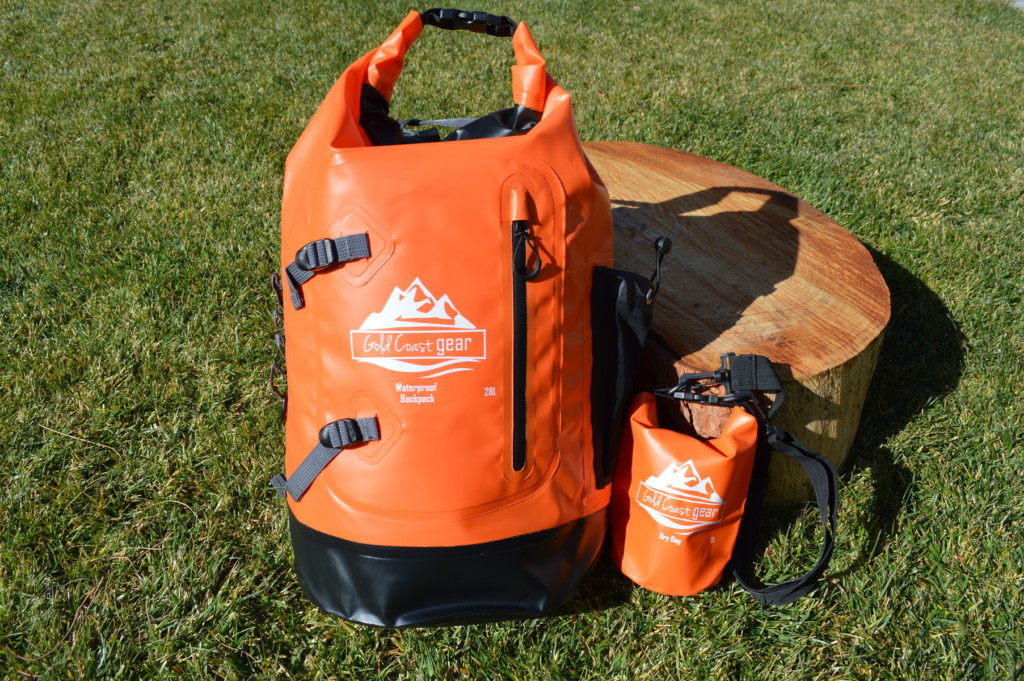
Stuff Sacks
Stuff sacks are a convenient way of organizing smaller items in your bag. I typically carry three in my backpack. These three little bags are different colors, so I can quickly determine which items are in separate bags.
While they’re not waterproof, they have a drawstring for quick access. What’s nice about stuff sacks is that they’re typically cheaper than dry bags and lighter too. The trade-off is that they’re not as robust.

Compression Sacks
A compression sack will reduce the volume of your sleeping bag and other gear. This will give you more room inside your backpack. There’s a lot of different compression sacks on the market but I’d only recommend a waterproof one for holding your sleeping bag. Compression sacks are also great for cinching clothes when you’re hiking in colder weather.
Sea to Summit is known for there well make compression sacks along with all there gear. Check out their features and current price on Amazon here.
The important thing to remember when researching camping gear is to not feel overwhelmed. All outdoor gear has it’s purpose but many things we carry in our packs make our time in the outdoors more comfortable, but not always necessary. Theirs so many options and variables I hope you found this guide helpful.
FAQ – Camping Bags
What’s a Camping Bag?
A camping bag is any container made of flexible material with an opening, used for carrying outdoor gear. That’s the definition but really a camping bag is a container specifically made for the type of camping and hiking you intend to do. Different style bags are used for all applications outdoors.
What’s the Most Common Size Dry Bag I Should Use?
The most common size is 5L but there is a wide range of sizes all up to 30L for carrying more of your camping gear.
What’s the Most Common Size for a Weekend Trip Hiking Backpack?
30 to 50 liters backpacks are great for overnighter and weekend trips. This size bag can be used for warmer weather where you don’t need a ton of winter gear. They are large enough for a tent and overnight gear. If you’re just starting out camping and hiking this is the size I’d recommend. You can always get a larger size to more experience you get on the trail.
Should I Use an Internal Frame of an External Frame Hiking Backpack?
Internal frame hiking backpacks are more common nowadays. An internal frame backpack is lighter than an external frame backpack while staying tight on your body.

